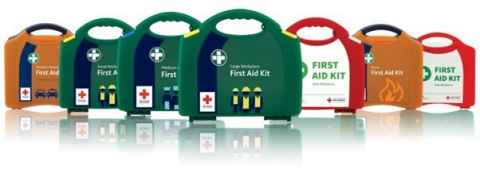First aid kits and defibrillators
Find out more about how to purchase first aid kits and defibrillators.
First aid kits

Staff information: buying and maintaining first aid kits and AEDs
First Aid kits at the University are bought, replenished and maintained locally by schools and departments.
Buying First Aid kits and supplies
HSW recommend the following, which are able to be purchased via NetXpress or Red Cross:
Content of a first aid kit
-
Content of a first aid kit. Size: 156.9 kB.
Document Description: List of what you need (as above), and how it might be laid out in your first aid kit.
Note: Prescription and non-prescription medication, creams, Epi-pens etc…must not be included in a first aid kit
Additional information about your first aid kits
- Contents: Kits should be checked at least monthly taking note of the expiry dates of supplies.
- Spares: It's handy to keep spares of items that run out quickly, e.g. plasters. Store separately. Remember the expiry dates.
- Specialised areas: For labs and other specialised areas such as catering areas, you would additionally have items that relate to the hazards, such as eye wash stations or urn dressings. A risk assessment is necessary to determine needs - the HSW team can help you with this.
- Over-the-counter pain relief: These items should not be kept in kits.
- Unreported use of items: If this is high, you should investigate.
- Signage: Install signage to show who the first aider is and how to contact them.
Defibrillators

How many AEDs do I need?
It is recommended that at least one AED is provided per building, or group of small, low-rise buildings located in close proximity.
This number may increase based on the following factors:
- The number of people who use the building and their age profile
- The size and layout of the building
- The nature of activities taking place in the building
- The presence of staff, students, patients etc… with a known history of cardiac issues
For sites with an elevated risk level, consider employing the three-minute rule to determine the required number of AEDs and their placement, i.e. is someone able to retrieve an AED from a designated point within the building and return it to the patient for immediate use within three minutes?
Buying AEDs and supplies
HSW recommend the following, which are able to be purchased via NetXpress or Red Cross:
Replacement pads and batteries
- If you have a different make/model, please contact HSW for advice on replacement parts.
- If you purchase an AED please inform HSW to enable it to be added to the University’s data base.
- HSW will also set up reminders for battery and pad replacement dates.
- It is recommended to purchase a carry sleeve and AED prep kit to accompany any AED.
- Defibrillators should be checked monthly to ensure they are operational.
AED status lights
To show that the AED is ready for use, it will display an icon. This may be a green flashing light, solid colour, a tick or the word 'OK'. If it is not displaying this symbol, something may be wrong with the machine.

Daily Visual Inspection
Undertake a simple visual inspection that the AED status light shows it is ready for use. If any obvious issues are observed, refer to the user manual or contact the supplier.
Monthly Recorded Checks
Check the units indicator to ensure it is ready to go, check it is in its correct location and there is no damage. Ensure that any accessories with it (prep kit, first aid items) are present and in good condition. Use the online check form (staff only access) or the printable AED Inspection Checklist below. Print a copy of the check form you complete and store it in the AED cabinet (and remove any previously printed monthly checklists)
Annual Inspection
Carry out an annual inspection to check expiry dates, damage, condition. Use the online annual inspection form (staff only access). Again, store a printed copy in the AED cabinet.
Document Control
Version: 2.2
Last Updated: Apr 2025
Next Review: Apr 2028
Owner: hsw@auckland.ac.nz
Approver: Associate Director, Health Safety & Wellbeing